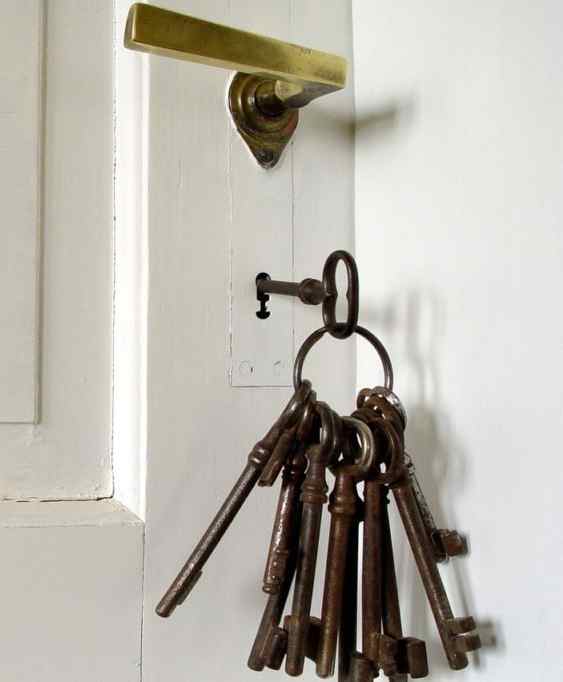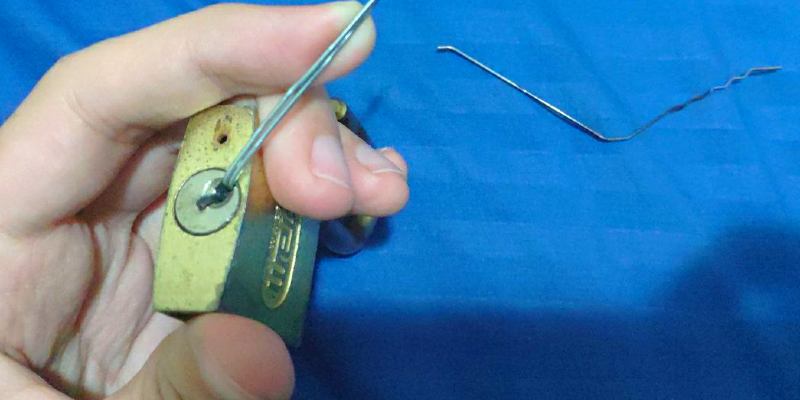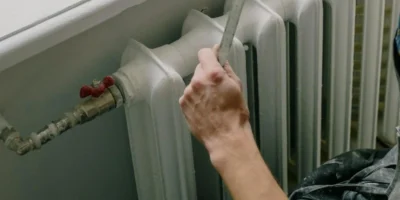Step-by-step guide on how to pick a lock on a door or padlock and how to pick a lock with a bobby pin or paper clip tools you make yourself in an emergency.
Find more home guides, tips and advice
The key is forgotten or a gust of wind throws the door closed and locked – it happens quickly. But don’t panic, there are many ways to get back into the house or apartment once you know how to pick a door lock and how to pick a padlock. We present different techniques.
How to pick a lock on a door: Instructions for beginners
A room door can be cracked relatively quickly even without experience or special tools. Most of the older doors have a so-called tumbler lock which offers little security. You can also pick a room door lock with simple tools, for example with a hexagon socket or Allen key.
Picking a tumbler lock
What is a tumbler lock ? A simple tumbler lock is a door lock that is mainly used in indoor doors because it offers only limited security. The lock is opened with a simple key and the entire mechanism is built into a so-called “mortise lock”. Tumbler locks offer little protection against attacks and are relatively easy to pick without special tools. That is why such locks are usually only found in interiors, basements or even in bathroom doors.

➤ Tumble locks are mainly found indoors
Simple door locks offer little security and can also be opened with simple household items such as wire or a coat hanger. In most cases you can save yourself the key service and pick the tumbler lock yourself – even without special lock picking tools.
There are special tools for this for relatively little money, but you can also bend a suitable tool yourself from a simple wire. Tumbler locks can usually be picked quickly and easily without special tools.
Before we get to the tools, you should first understand very briefly how a tumbler lock works. So when you open the lock you know exactly what to do and how to open the door again without a key.
The mechanism
The only important part is the mechanism that opens the tumbler lock. In the lock there is a bolt plate and a tumbler, the key pushes the plate to the side and the tumbler lock is opened.
The keys of such locks only differ in the milling so that each key only fits into a certain lock. The mechanics remain the same, which is why it is so easy to pick a tumbler lock.

professional lockpicks
With tumbler locks, you ultimately only have to enter the lock with any object and then move the plate and thus open the tumbler lock without a key. It will always take a while to pick a door lock yourself, so take your time.
In the vast majority of cases, a simple piece of wire or a tool from the tool box is enough to make a lockpicking hook yourself. The material just has to be strong enough so that it doesn’t give way or deform under pressure. So if you use a wire, it should be as thick as possible.
Opening tumbler locks with wire
You can usually open any tumbler lock with a simple piece of wire, you just have to bend it into a suitable shape and then know the right technique. Alternatively, you can use the wire from a clothes hanger. It is only important that the material does not bend. When bending your wire, you can use the shape of professional lock picking tools as a guide.
Opening tumbler locks with a tool
You can of course also use a tool that has a suitable shape, such as a small Allen key. The technology remains the same – insert the tumbler lock and simply turn it around.
Opening pin cylinder or warded locks and how to pick a padlock
A warded lock uses a set of obstructions, or wards, to prevent the lock from opening unless the correct key is inserted. The key has notches or slots that correspond to the obstructions in the lock, allowing it to rotate freely inside the lock.
The pin cylnder lock uses a set of pins to prevent the lock from opening unless the correct key is inserted. The key has a series of grooves on either side of the key’s blade that limit the type of lock the key can slide into. As the key slides into the lock, the horizontal grooves on the blade align with the wards in the keyway allowing or denying entry to the cylinder. A series of pointed teeth and notches on the blade, called bittings, then allow pins to move up and down until they are in line with the shear line of the inner and outer cylinder, allowing the cylinder or cam to rotate freely and the lock to open.
How to pick a lock with a paper clip
First the classics: Picking a door cylinder lock with everyday objects – such as hairpins, paper clips , etc. But is that possible?
In any case, even with very simple tools, a door lock can be opened without a key. At the same time, however, you will not be successful if you have never practiced such techniques. Nobody can pick a door lock off the cuff with everyday objects.
Realistic assessment: If you’ve never done it before, then you won’t be able to pick the door lock “just like that”.
What you need
You don’t need more than 2 paper clips from which you can make the two tools you need . You can also use pliers to bend the paper clip into the correct shape. It is best to take several paper clips with you, because it often takes several tries before the paper clip is bent correctly. It’s nothing more than that – 2 paper clips are really enough to pick a lock!
Choose the right paper clips to pick the lock
Not every paper clip is suitable for picking a lock – I made the same mistake at the beginning. So what do you have to consider?
The only one important point: Use the most stable, uncoated paper clip possible.
Colored or coated paper clips are usually unsuitable because they bend too quickly. If the clamps are too unstable it will be impossible to use them to open a lock. So make sure you use the right material – the more stable, the better! Uncoated paper clips that are as stable as possible are best for cracking the lock.
Next, use the two paper clips to make the 2 lockpicking tools you need. One tool is used to keep the lock under tension (“ spanner ”) and the other is used to depress the pins in the lock (“lock picker”).
You will now find out how exactly this works and what you have to do.
THE TENSIONER – TOOL 1
The tensioner is used to keep the cylinder under tension from the lock . This is necessary to keep the depressed pins in place. As soon as you feel a jolt, you can turn the cylinder with the tensioner and open the lock.
It is therefore important that the tensioner is made from a sturdy paper clip.
Method to build your own tensioner

TEST THE TENSIONER
Once you’ve made the tensioner, you need to see if it’s the right size. To do this, you insert it into the cylinder. As soon as it is in the lock, you see if you can use the tensioner to apply pressure to the cylinder. You don’t need a lot of strength for this, but the tensioner must not bend under any circumstances ! If so, you need a better paper clip.
THE SIZE OF THE TENSIONER
The tensioner does not have to be particularly large, it is only important that the part in the lock is tilted in the cylinder and that you can apply pressure. Depending on the lock, 1-2 cm is enough, you don’t need more.
How long the other side is (the one that looks out of the lock) is entirely up to you. You should be able to apply constant pressure with one of your fingers as comfortably as possible without your hand cramping.
Don’t worry too much here, just try it out and see what works!
If everything fits, you can use the tensioner to turn the cylinder slightly in the right direction without it bending.
THE LOCK PICKER – TOOL 2
The lock is picked with the lock picker, i.e. the pins are put in the right place. So this tool is inserted into the cylinder and the pins are pushed down.
Step by step instructions for making from a paper clip

How to pick a lock with a bobby pin
The method for how to pick a lock with a bobby pin follows the same instructions we have given above for how to pick a lock with a paper clip. From reading those, the first thing you will realise is that most bobby pins are too weak and small for the task. Only the very largest of bobby pins will have the length and strength to do the job.
If you have 2 large bobby pins at hand, fashion them into the tensioner and pick tools as decribed in the diagrams above for the paper clip, then follow the manipulating instructions below.
TEST THE LOCK PICKER
The lock picker must fit into the cylinder at the same time as the tensioner , so first you insert the tensioner into the lock and then test whether you still have enough space with the picker to reach the pins from the lock.
The aim is to press the pins down one after the other, as soon as they are all in the right place, the lock can be opened. But so that the pins do not spring back immediately, you need constant pressure with the tensioner on the cylinder.
How to pick a lock with a bobby pin or paper clip – instructions for manipulating the lock
Now for the interesting part: What do you have to do to pick a lock with a paper clip or bobby pin? To help you understand what happens inside a lock, here are a few necessary basics:

- The cylinder [1] is the part that can be turned when you open a lock.
- The pins [2] (or safety pins ) ensure that the cylinder cannot be turned. The lock can only be opened when all pins are in the right place.

So now you’re using your tools to try to move the pins down one after the other and get them all in the right position.

- First you insert the tensioner into the cylinder (see image above) and check whether you can apply pressure to the cylinder. It is important that you turn the tensioner in the right direction, otherwise the lock will not work with the paper clips.
- If you apply slight pressure, you will normally notice that the cylinder blocks completely in one direction, but gives way a little in the other direction, this direction is the right one!
- The tensioner is inserted on the opposite side of the pins so that you can later easily press down all pins with the lock picker. We have marked this point in the picture.
- If the tensioner is too small, then you have no hold in the cylinder – you need a larger / wider tensioner.
- If the tensioner doesn’t fit in the cylinder or takes up way too much space, downsize it.
Manipulating the pins

The actual lock picking happens with the picker. As soon as the tensioner is in place, you can try to manipulate the pins with the lock picker.
- To do this, insert the picker into the cylinder (see image above) and press the pins in the lock.
- If the picker bends, you’ll need a sturdier paper clip!
- This part of lock picking is the hardest, and it will take a while to figure out what works and what doesn’t. If you want to pick a simple, relatively insecure lock with a paper clip, you can try the following technique.
- Apply light pressure on the tensioner and insert the lock picker into the cylinder.
- Now you can move the picker back and forth while holding the pressure on the tensioner.
- If nothing happens after about 30 seconds, take the pressure off the tensioner and start all over again.
PICK THE DOOR LOCK WITH A SPECIAL TOOL
It looks different when special tools are used. Lockpicking deals with the non-destructive opening of locks and lock cylinders – so it is definitely possible.
With the right tools and the right technology, you can open a door lock without a key.
How to pick a lock on a door: the ‘bump’ key
One of the fastest and most effective methods of picking a door lock is the bump key. Simply put, it is a kind of universal key that can be used for a large number of door locks.
To crack a door with it, the bump key is simply inserted into the lock from the outside and off you go: the bump key is turned at the same time and you hit the key lightly with a special hammer.
This manipulates the pins in the cylinder lock and the door lock can be opened ( percussion method ).
If you want to learn more about it, you can read our guide. Bump key technology
PICK THE DOOR LOCK WITH THE PICK PISTOL / ELECTRIC PICK
These two techniques are also extremely effective and very suitable for opening door locks without a key.
Just like the bump wrench, the pick pistol and the electric pick are based on the percussion method. You put these tools to the door lock, so you click the pins in the lock cylinder, keep the lock under tension and start pecking.
The pins of the two tools are knocked down and manipulated in this way. With enough practice, doors can be cracked in a few minutes.
OPEN THE LOCK CYLINDER WITH LOCK PICKING TOOLS
The classic method: the proven lock picking with conventional lock picking tools. This is where door locks are more of a challenge than padlocks, for example, so you definitely need practice.
The technique of lock picking is actually always the same, you keep the cylinder under tension and then start setting the pins. You can do this by looking at our great guide to how to pick a lock and how to pick a padlock. Note, however, that this will take a lot of time and practice!
FAQ – Frequent questions about picking the door lock
How can you open a closed door yourself?
If the door has slammed, you can open the door relatively easily with a plastic card or other everyday object. All you have to do is press the latch on the door from the outside.
How long does it take to open a locked door lock?
Depending on whether the door is locked or just closed, it can take a few minutes or several hours before the door is opened again.
Can you pick a door lock with a hairpin or a paper clip?
The idea of opening a door with simple objects such as hairpins or paper clips is possible, but requires a lot of practice and experience.
Can ABUS door locks also be cracked?
The ABUS brand stands for security, but no lock is perfect. ABUS locks can also be opened with the right technology without a key.
What tools do I need to pick a door lock?
If the door has slammed, a simple plastic card is sufficient; if the door is locked, you need special lockpicking tools to open it.
Can you pick a door lock without any experience?
It depends a lot on what tools you have. Without experience and the right tools, it is almost impossible to open a locked door.




